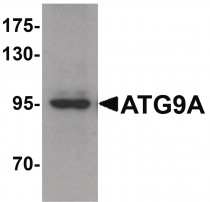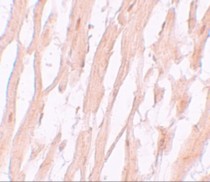ARG54920
anti-ATG9A antibody
anti-ATG9A antibody for ELISA,ICC/IF,IHC-Formalin-fixed paraffin-embedded sections,Western blot and Human,Mouse,Rat
Cancer antibody; Cell Biology and Cellular Response antibody; Cell Death antibody; Metabolism antibody; Neuroscience antibody
Overview
| Product Description | Rabbit Polyclonal antibody recognizes ATG9A |
|---|---|
| Tested Reactivity | Hu, Ms, Rat |
| Tested Application | ELISA, ICC/IF, IHC-P, WB |
| Host | Rabbit |
| Clonality | Polyclonal |
| Isotype | IgG |
| Target Name | ATG9A |
| Antigen Species | Human |
| Immunogen | Synthetic peptide (18 aa) within aa. 720-770 of Human ATG9A. |
| Conjugation | Un-conjugated |
| Alternate Names | APG9L1; MGD3208; APG9-like 1; mATG9; Autophagy-related protein 9A |
Application Instructions
| Application Suggestion |
|
||||||||||
|---|---|---|---|---|---|---|---|---|---|---|---|
| Application Note | * The dilutions indicate recommended starting dilutions and the optimal dilutions or concentrations should be determined by the scientist. | ||||||||||
| Positive Control | Mouse Heart Tissue Lysate |
Properties
| Form | Liquid |
|---|---|
| Purification | Affinity purification with immunogen. |
| Buffer | PBS and 0.02% Sodium azide |
| Preservative | 0.02% Sodium azide |
| Concentration | 1 mg/ml |
| Storage Instruction | For continuous use, store undiluted antibody at 2-8°C for up to a week. For long-term storage, aliquot and store at -20°C or below. Storage in frost free freezers is not recommended. Avoid repeated freeze/thaw cycles. Suggest spin the vial prior to opening. The antibody solution should be gently mixed before use. |
| Note | For laboratory research only, not for drug, diagnostic or other use. |
Bioinformation
| Database Links | |
|---|---|
| Gene Symbol | ATG9A |
| Gene Full Name | autophagy related 9A |
| Background | ATG9A Antibody: Autophagy, the process of bulk degradation of cellular proteins through an autophagosomic-lysosomal pathway is important for normal growth control and may be defective in tumor cells. It is involved in the preservation of cellular nutrients under starvation conditions as well as the normal turnover of cytosolic components. This process is negatively regulated by TOR (Target of rapamycin) through phosphorylation of autophagy protein APG1. ATG9A, a multi-spanning membrane protein localizing to the Golgi apparatus and late endosomes, has been proposed to mediate membrane transport to generate autophagosomes. ATG9A has also been implicated as a regulator of STING (stimulator of interferon genes)-mediated innate immune response. |
| Function | Involved in autophagy and cytoplasm to vacuole transport (Cvt) vesicle formation. Plays a key role in the organization of the preautophagosomal structure/phagophore assembly site (PAS), the nucleating site for formation of the sequestering vesicle. Cycles between a juxta-nuclear trans-Golgi network compartment and late endosomes. Nutrient starvation induces accumulation on autophagosomes. Starvation-dependent trafficking requires ULK1, ATG13 and SUPT20H. [UniProt] |
| Research Area | Cancer antibody; Cell Biology and Cellular Response antibody; Cell Death antibody; Metabolism antibody; Neuroscience antibody |
| Calculated MW | 94 kDa |
Images (3) Click the Picture to Zoom In
-
ARG54920 anti-ATG9A antibody WB image
Western blot: mouse heart tissue lysate stained with ARG54920 anti-ATG9A antibody at 1 ug/ml dilution.
-
ARG54920 anti-ATG9A antibody IHC image
Immunohistochemistry: ATG9A in human heart tissue stained with ARG54920 anti-ATG9A antibody at 20 ug/ml dilution.
-
ARG54920 anti-ATG9A antibody IHC image
Immunohistochemistry: ATG9A in human heart tissue stained with ARG54920 anti-ATG9A antibody at 5 ug/ml dilution.








